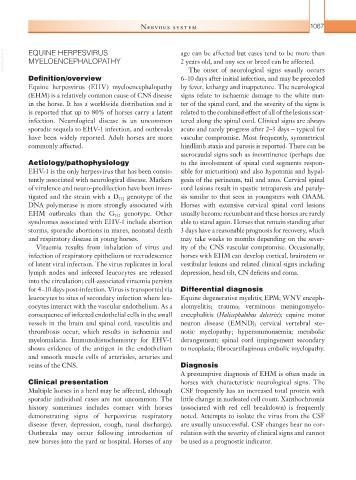Page 1092 - Equine Clinical Medicine, Surgery and Reproduction, 2nd Edition
P. 1092
Nervous system 1067
VetBooks.ir EQUINE HERPESVIRUS age can be affected but cases tend to be more than
MYELOENCEPHALOPATHY
2 years old, and any sex or breed can be affected.
The onset of neurological signs usually occurs
Definition/overview 6–10 days after initial infection, and may be preceded
Equine herpesvirus (EHV) myeloencephalopathy by fever, lethargy and inappetence. The neurological
(EHM) is a relatively common cause of CNS disease signs relate to ischaemic damage to the white mat-
in the horse. It has a worldwide distribution and it ter of the spinal cord, and the severity of the signs is
is reported that up to 80% of horses carry a latent related to the combined effect of all of the lesions scat-
infection. Neurological disease is an uncommon tered along the spinal cord. Clinical signs are always
sporadic sequela to EHV-1 infection, and outbreaks acute and rarely progress after 2–3 days – typical for
have been widely reported. Adult horses are more vascular compromise. Most frequently, symmetrical
commonly affected. hindlimb ataxia and paresis is reported. There can be
sacrocaudal signs such as incontinence (perhaps due
Aetiology/pathophysiology to the involvement of spinal cord segments respon-
EHV-1 is the only herpesvirus that has been consis- sible for micturition) and also hypotonia and hypal-
tently associated with neurological disease. Markers gesia of the perineum, tail and anus. Cervical spinal
of virulence and neuro-predilection have been inves- cord lesions result in spastic tetraparesis and paraly-
tigated and the strain with a D genotype of the sis similar to that seen in youngsters with OAAM.
752
DNA polymerase is more strongly associated with Horses with extensive cervical spinal cord lesions
EHM outbreaks than the G genotype. Other usually become recumbent and these horses are rarely
752
syndromes associated with EHV-1 include abortion able to stand again. Horses that remain standing after
storms, sporadic abortions in mares, neonatal death 3 days have a reasonable prognosis for recovery, which
and respiratory disease in young horses. may take weeks to months depending on the sever-
Viraemia results from inhalation of virus and ity of the CNS vascular compromise. Occasionally,
infection of respiratory epithelium or recrudescence horses with EHM can develop cortical, brainstem or
of latent viral infection. The virus replicates in local vestibular lesions and related clinical signs including
lymph nodes and infected leucocytes are released depression, head tilt, CN deficits and coma.
into the circulation; cell-associated viraemia persists
for 4–10 days post-infection. Virus is transported via Differential diagnosis
leucocytes to sites of secondary infection where leu- Equine degenerative myelitis; EPM; WNV enceph-
cocytes interact with the vascular endothelium. As a alomyelitis; trauma; verminous meningomyelo-
consequence of infected endothelial cells in the small encephalitis (Halicephalobus deletrix); equine motor
vessels in the brain and spinal cord, vasculitis and neuron disease (EMND); cervical vertebral ste-
thrombosis occur, which results in ischaemia and notic myelopathy; hyperammonaemia; metabolic
myelomalacia. Immunohistochemistry for EHV-1 derangement; spinal cord impingement secondary
shows evidence of the antigen in the endothelium to neoplasia; fibrocartilaginous embolic myelopathy.
and smooth muscle cells of arterioles, arteries and
veins of the CNS. Diagnosis
A presumptive diagnosis of EHM is often made in
Clinical presentation horses with characteristic neurological signs. The
Multiple horses in a herd may be affected, although CSF frequently has an increased total protein with
sporadic individual cases are not uncommon. The little change in nucleated cell count. Xanthochromia
history sometimes includes contact with horses (associated with red cell breakdown) is frequently
demonstrating signs of herpesvirus respiratory noted. Attempts to isolate the virus from the CSF
disease (fever, depression, cough, nasal discharge). are usually unsuccessful. CSF changes bear no cor-
Outbreaks may occur following introduction of relation with the severity of clinical signs and cannot
new horses into the yard or hospital. Horses of any be used as a prognostic indicator.

